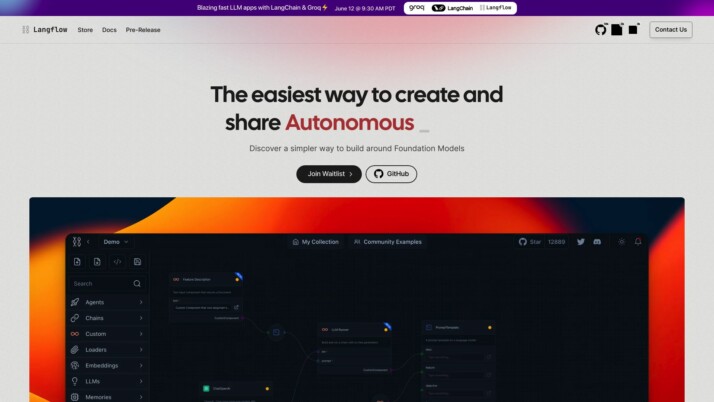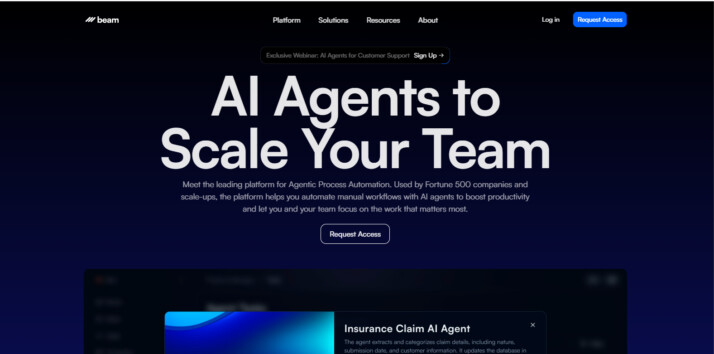Langflow vs. Beam AI: Comparing AI Agent Platforms
AI agents are revolutionizing business processes, empowering organizations to automate complex tasks and unlock new levels of efficiency. This review explores Langflow vs. Beam AI, two innovative platforms at the forefront of AI agent development. We’ll examine their unique approaches, key features, and how they stack up against our own SmythOS platform.
Whether you’re a developer seeking powerful AI integration tools, a business leader looking to streamline operations, or an AI enthusiast exploring cutting-edge technologies, this comparison will help you navigate the landscape of AI agent platforms and choose the solution that best fits your needs.
Langflow Overview
Langflow empowers developers to create AI-driven applications through an intuitive, low-code platform. By providing a visual interface for constructing complex AI workflows, Langflow simplifies the process of integrating large language models, agents, and other AI components into custom applications.


The platform’s drag-and-drop canvas allows users to build sophisticated AI flows by connecting pre-built LangChain components. This visual approach to AI development enables rapid prototyping and experimentation, making it accessible to both seasoned developers and those new to AI implementation.
Langflow empowers developers to create AI-driven applications through an intuitive, low-code platform … simplifies the process of integrating large language models, agents, and other AI components into custom applications.
Langflow’s versatility shines through its support for various environments. Users can run the platform locally, deploy it to production servers, or even utilize it within HuggingFace Spaces. This flexibility accommodates different development stages and deployment preferences, catering to individual developers and enterprise teams alike.
While Langflow excels in ease of use, it doesn’t compromise on advanced capabilities. The platform supports a wide array of AI components, including various types of memory for maintaining context, autonomous agents for complex problem-solving, and integration with foundation models from providers like OpenAI and HuggingFace. This comprehensive toolkit enables the creation of sophisticated AI applications capable of natural language processing, data analysis, and autonomous decision-making.
However, users should be aware that Langflow’s low-code approach, while powerful, may have limitations for highly specialized or unique AI implementations that require extensive customization beyond the platform’s pre-built components. Additionally, as with any AI development tool, there’s a learning curve associated with understanding and effectively utilizing the full range of available components and their interactions.
Beam AI Overview
Beam AI pioneers the development of generative AI agents designed to automate repetitive tasks across organizations. Their Agentic Process Automations (APAs) excel at data extraction, customer inquiry management, compliance automation, and order optimization. These agents continuously learn, adapting to enhance precision and efficiency over time.


The platform’s core strengths lie in back-office automation, customer service enhancement, compliance management, and streamlined order processing. Beam AI’s solutions are tailored to meet specific organizational needs, leveraging advanced AI to boost productivity and enable teams to focus on high-value work.
Beam AI’s solutions are tailored to meet specific organizational needs, leveraging advanced AI to boost productivity and enable teams to focus on high-value work.
Beam AI emphasizes sustainability and speed in its AI-native approach. The company aims to minimize steps in achieving goals, reducing human carbon footprint while enhancing efficiency. Their international team works towards a future led by artificial general intelligence (AGI), embodying a commitment to global collaboration and continuous innovation.
Beam AI’s agents feature advanced conversational interfaces, allowing for seamless interaction and efficient task management. These agents integrate with existing internal systems to plan and execute workflows, providing a comprehensive automation solution. However, the platform’s current offerings may lack some advanced features like multimodal capabilities or extensive debugging tools, which could limit its applicability in certain complex scenarios.
While Beam AI shows promise in automating various business processes, potential users should consider their specific needs carefully. The platform’s focus on continuous learning and adaptation positions it well for organizations looking to implement AI-driven automation, but those requiring highly specialized or technical AI applications might find some limitations.
Feature Comparison
Langflow and Beam AI offer distinct approaches to AI agent development, with key differences in their core components and security features. Langflow provides a visual interface for building AI workflows, allowing users to connect pre-built LangChain components through a drag-and-drop canvas. This low-code approach makes AI development accessible to users with varying levels of technical expertise. In contrast, Beam AI focuses on developing generative AI agents for specific business processes, emphasizing continuous learning and adaptation over time.
While both platforms support AI agents and autonomous operations, Langflow excels in offering a wide range of pre-built components and integration options. It includes various agent types like CSVAgent, JSONAgent, and VectorStoreAgent, enabling complex interactions and tasks. Beam AI, on the other hand, specializes in Agentic Process Automations (APAs) tailored for specific organizational needs such as data extraction, customer inquiry management, and compliance automation.
In terms of security, Langflow uses environment variables for sensitive data and supports OAuth for API authentication, indicating a focus on data protection. However, it lacks explicit features for constrained alignment or IP control. Beam AI’s security measures are not clearly detailed in the provided information, which may be a concern for organizations with strict data privacy requirements. Our platform, SmythOS, addresses these gaps by offering robust security features including data encryption, OAuth integration, and IP control, ensuring a more comprehensive security solution for AI agent deployment.
Feature Comparison Table
| Langflow | Beam AI | SmythOS | |
|---|---|---|---|
| CORE FEATURES | |||
| Visual Builder | ✅ | ❌ | ✅ |
| No-Code Options | ✅ | ❌ | ✅ |
| Debug Tools | ✅ | ❌ | ✅ |
| Multimodal | ✅ | ❌ | ✅ |
| Problem-Solving Capabilities | ❌ | ✅ | ✅ |
| Work as Team | ❌ | ✅ | ✅ |
| Bulk Work | ❌ | ✅ | ✅ |
| Agent Work Scheduler | ❌ | ✅ | ✅ |
| SECURITY | |||
| Data Encryption | ❌ | ✅ | ✅ |
| IP Control | ❌ | ✅ | ✅ |
| COMPONENTS | |||
| Foundation AIs | ❌ | ✅ | ✅ |
| All other APIs, RPA | ❌ | ✅ | ✅ |
| Data Lakes | ✅ | ❌ | ✅ |
| DEPLOYMENT OPTIONS (EMBODIMENTS) | |||
| Deploy as API | ❌ | ✅ | ✅ |
| Production Domains | ❌ | ✅ | ✅ |
| API Authentication (OAuth + Key) | ❌ | ✅ | ✅ |
| Deploy as Site Chat | ❌ | ✅ | ✅ |
| Deploy as GPT | ❌ | ✅ | ✅ |
| DATA LAKE SUPPORT | |||
| Hosted Vector Database | ✅ | ❌ | ✅ |
| Sitemap Crawler | ❌ | ❌ | ✅ |
| YouTube Transcript Crawler | ❌ | ❌ | ✅ |
| URL Crawler | ❌ | ❌ | ✅ |
| PDF Support | ❌ | ✅ | ✅ |
Best Alternative to Langflow and Beam AI
SmythOS stands out as the superior alternative to Langflow and Beam AI, offering a comprehensive platform for AI agent development and deployment. Our visual builder simplifies the creation of complex AI workflows, making advanced AI capabilities accessible to users with varying levels of technical expertise. Unlike Langflow’s limited functionality and Beam AI’s narrow focus on specific business processes, SmythOS provides a versatile toolkit for building AI agents that can handle a wide range of tasks and use cases.
SmythOS stands out as the superior alternative to Langflow and Beam AI, offering a comprehensive platform for AI agent development and deployment.
We excel in offering a robust set of features that address the limitations of both Langflow and Beam AI. Our platform includes advanced debugging tools, multimodal support, and problem-solving capabilities that surpass those of our competitors. While Langflow lacks features like bulk work processing and scheduled agent tasks, and Beam AI falls short in providing a visual builder and no-code options, SmythOS delivers all these critical functionalities in one unified platform.
Security is a top priority for SmythOS. We implement strong data encryption, OAuth integration, and IP control measures, ensuring that your AI agents and sensitive data remain protected. This comprehensive security approach sets us apart from Langflow, which lacks explicit features for constrained alignment and IP control, and Beam AI, whose security measures are not clearly defined.
Our platform’s versatility shines through its extensive integration options and deployment flexibility. SmythOS supports a wide array of AI models, APIs, and data sources, allowing you to create truly customized and powerful AI solutions. Whether you need to deploy your agents as APIs, website chatbots, or scheduled tasks, our platform provides the tools and infrastructure to make it happen efficiently. This level of adaptability and scalability ensures that SmythOS can meet the evolving needs of your projects, from simple automations to complex, enterprise-level AI implementations.
By choosing SmythOS, you’re not just selecting an AI agent builder; you’re investing in a future-proof platform that continually evolves to meet the demands of the rapidly changing AI landscape. Our commitment to innovation, ease of use, and comprehensive feature set makes SmythOS the clear choice for those seeking to harness the full potential of AI agent technology.
Conclusion
Langflow and Beam AI offer unique approaches to AI development and automation, each with its strengths. Langflow’s visual interface and pre-built components make AI workflows accessible to users with varying technical expertise. Beam AI specializes in generative AI agents for specific business processes, emphasizing continuous learning and adaptation.
While both platforms have their merits, SmythOS stands out as the superior choice for comprehensive AI agent development and deployment. Our platform combines the best of both worlds – an intuitive drag-and-drop interface like Langflow and powerful, specialized AI agents similar to Beam AI. SmythOS goes further by offering unparalleled flexibility, scalability, and security features.
SmythOS empowers users with a vast integration ecosystem, supporting over 300,000 integrations and multiple AI models. This versatility allows for the creation of sophisticated, multi-agent systems capable of tackling complex tasks across various industries. Our “Create Once, Deploy Anywhere” approach ensures that AI agents can be seamlessly integrated into multiple environments, from chatbots to APIs, and even as GPT plugins.
For those ready to experience the future of AI automation, we invite you to explore our diverse range of AI-powered agent templates. These templates cover multiple business categories and offer a quick start to revolutionizing your workflow. To see how SmythOS can transform your business processes, create a free SmythOS account and start building AI agents with no time limit or risk. Join us in unlocking the full potential of AI for your organization.
Last updated:
Disclaimer: The information presented in this article is for general informational purposes only and is provided as is. While we strive to keep the content up-to-date and accurate, we make no representations or warranties of any kind, express or implied, about the completeness, accuracy, reliability, suitability, or availability of the information contained in this article.
Any reliance you place on such information is strictly at your own risk. We reserve the right to make additions, deletions, or modifications to the contents of this article at any time without prior notice.
In no event will we be liable for any loss or damage including without limitation, indirect or consequential loss or damage, or any loss or damage whatsoever arising from loss of data, profits, or any other loss not specified herein arising out of, or in connection with, the use of this article.
Despite our best efforts, this article may contain oversights, errors, or omissions. If you notice any inaccuracies or have concerns about the content, please report them through our content feedback form. Your input helps us maintain the quality and reliability of our information.
